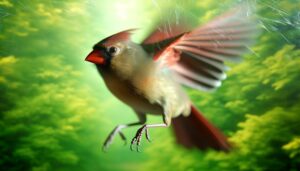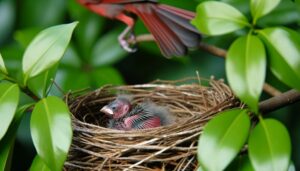How to Put a Baby Cardinal Back in Its Nest Safely
Yes, you can put a baby cardinal back in its nest, but first, assess its condition. Check for injuries, dehydration, and abnormal behaviors.
Observe nearby adult cardinals for feeding and protective actions. Locate the nest by scanning trees and shrubs where adults often visit.
Handle the baby bird with clean hands and gloves, moving gently to reduce stress. After returning it to the nest, closely monitor interactions and feeding behavior by the parents.
If the chick appears distressed or the parents don't return, consulting a wildlife rehabilitator is advisable. Ensuring these steps can improve the chick's chances of survival.

Key Takeaways
- Yes, you can put a baby cardinal back in its nest if it appears uninjured.
- Ensure your hands are clean or wear disposable gloves to avoid transferring oils or contaminants.
- Gently place the baby bird back in the nest to prevent causing stress or injury.
- Observe from a distance to ensure the parents return and continue caring for the chick.
- Contact a wildlife rehabilitator if the baby bird seems distressed or if the parents do not return.
Assess the Baby Cardinal's Condition
Carefully observe the baby cardinal's physical appearance and behavior to determine if it's injured or in distress. Look for visible signs of injury such as broken wings, bleeding, or abnormal posture.
Check for signs of dehydration or malnutrition by examining the skin around its beak and eyes; dry, wrinkled skin can indicate dehydration.
Assess its behavior—if it's lethargic, not making noises, or unable to stand, these can be indicators of distress. Note if the bird's feathers are fluffed up unusually, which can signify illness.
Examine its breathing; rapid or labored breathing might suggest respiratory issues. By systematically evaluating these factors, you'll gain a clear understanding of the baby cardinal's overall health and immediate needs.
Observe Nearby Adult Cardinals
Watching the nearby adult cardinals can provide important information about the baby bird's situation and whether its parents are still actively caring for it. Carefully observe the adults' behavior to gather evidence:
- Feeding Patterns: Notice if the adults frequently visit the baby with food.
- Protective Behavior: Look for signs of aggression or distress if you approach the baby.
- Vocalizations: Listen for specific calls that might indicate communication between the adults and the baby.
- Proximity: Observe if the adults maintain a close distance to the baby, indicating ongoing care.
These behaviors can affirm that the baby still has parental support and reduce the need for human intervention, ensuring you make an informed decision about returning it to the nest.
Determine the Nest's Location
To locate the nest, you should systematically scan the surrounding trees and shrubs, focusing on areas where adult cardinals are frequently seen entering or exiting. Cardinals often build nests in dense foliage, typically 3 to 10 feet above the ground.
Use binoculars to observe any consistent movement patterns of the adults. They may carry food or nesting materials, providing significant evidence of nest location. Look for nests constructed from twigs, grass, and leaves, often well-hidden within branches.
If you spot a nest, confirm it belongs to cardinals by identifying the adult birds or their distinctive calls nearby. Document your findings and surroundings meticulously to make sure you correctly identify the nest without disturbing other wildlife.
Safely Handle the Baby Bird
Once you've identified the nest's location, be sure you handle the baby bird with clean, dry hands to minimize the risk of transmitting oils or contaminants that could harm its delicate skin and feathers.
Follow these steps:
- Cleanse your hands thoroughly – Use soap and warm water to remove any potential pathogens.
- Put on disposable gloves – This adds an extra layer of protection, reducing the risk of contamination.
- Gently scoop the bird – Place one hand under its body and the other over its back to prevent it from flailing.
- Maintain movements slow and steady – Sudden actions can startle the bird, increasing stress and the risk of injury.
These careful handling practices assure the baby cardinal remains safe during the transfer back to its nest.
Monitor After Returning to Nest
After returning the baby cardinal to its nest, closely observe its behavior and interactions to guarantee it's accepted by its parents and shows signs of normal activity.
Watch for the parents feeding the chick, as this indicates acceptance. If the parents don't return within an hour, the chick may be abandoned.
Monitor the chick's vocalizations; healthy chicks typically chirp to signal hunger. Ensure the chick exhibits natural preening and stretching behaviors.
Use binoculars to minimize disturbance. If the chick appears lethargic or distressed, consult a wildlife rehabilitator.
Document these observations to provide accurate information to professionals if intervention is necessary. Your detailed monitoring is crucial for the chick's survival and reintegration into its natural environment.
Conclusion
Like a gardener nurturing a delicate seedling, you've carefully assessed the baby cardinal's condition, observed the bustling adult activity, and pinpointed the nest's location.
Gently, with the precision of a surgeon, you've handled the fragile bird and returned it to its haven.
Now, like a vigilant scientist, you monitor the nest, ensuring the cycle of life continues uninterrupted.
Your actions, grounded in observation and evidence, have given this tiny life a fighting chance to flourish.






